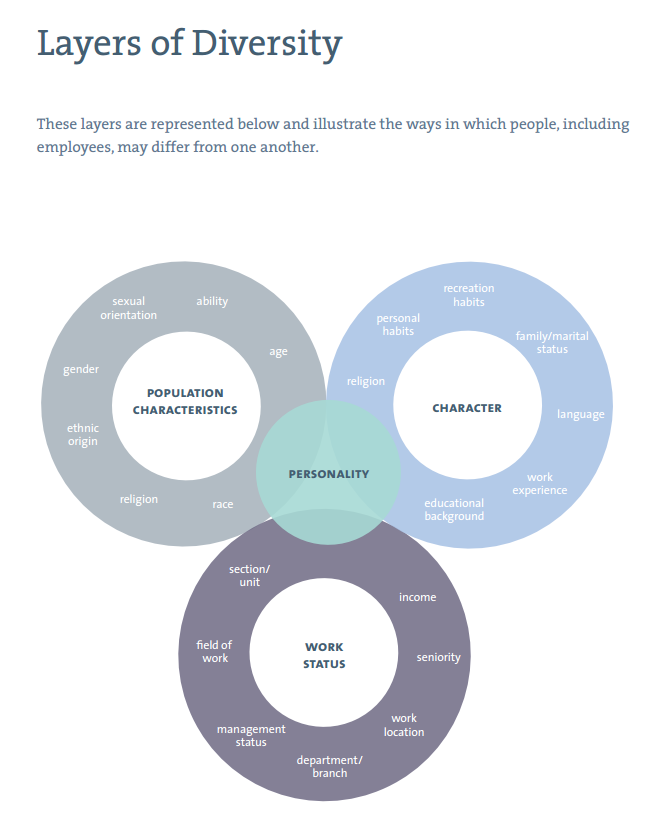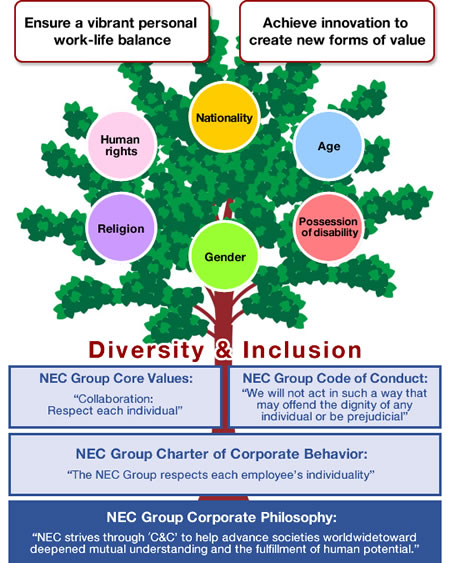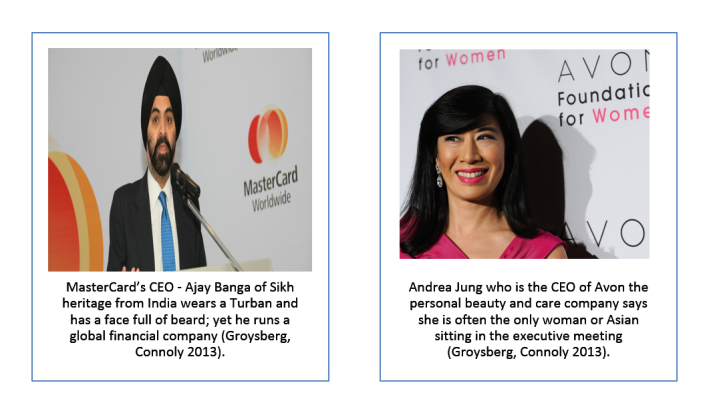Theme 1 – Diversity and Team Management
Part 1
Team development has always been a vital point to building a successful team. Many theories have been derived to glamorise the different aspects of a team. However, effective leadership has been recognised as a factor of success within an organisation (Hargis, Watt, Piotrowski 2011). Diversity can be achieved by taking into consideration, respecting and valuing each individual’s differences (The City of Edmonton 2013). Leaders today require the capability to harness ideas, people and resources from different aspects (Ibarra and Hansen 2011).
Figure 1 Layers of Diversity (The City of Edmonton 2013)
The world of work is changing (Kravitz, 2006). Diversity at work refers to the structure of your team in their language, religion, social status, cultural differential, experiences and physical or mental attributes (Welinder, Araujo and Lynn 2012). How the manager sees the diversity impacts how well the team would perform. The advantages of a diverse team can see people of different culture and religion work together and this tends to bring new innovations to the team (Merrill-Sands, Holvino and Cumming 2000). They also share their knowledge on marketing to a diverse consumer market to profit the company. Of course, you would have a bigger variety of talents to work with hence having better chances of optimised results.
However, there can also be disadvantages arising when there are people of different race or culture working today (Merrill-Sands, Holvino and Cumming 2000). With different cultures and religions, there is a tendency to offend people who come from a belief. There can be moments when decision making can be affected due to the diverse behaviour in the team thus impacting your results and affecting the team’s productivity (Welinder, Araujo and Lynn 2012).
Part 2
Figure 2 (NEC 2013)
NEC has shown dedication in promoting diversity across the company (2013). They have successfully recruited multi-cultural employees, promote women as leaders and even hiring people with disabilities as part of their diversity plan (NEC 2013). Other than race, gender, age, nationality, ethnicity, religion and disability; the company also recognise the diversity of working styles, careers, perspectives, values of the employees (NEC 2013). NEC has a diverse working system implemented for seniors so they can choose either a career support program or extend employment beyond retirement age (NEC 2013). The company insist on a healthy work-life balance, childcare and nursing care subsidies were made available to both male and female employees (NEC 2013).
 IKEA’s previous CEO Mikael Ohlsson says that his leadership on diversity is vision-driven from a business point of view and value-driven at the foundation (Groysberg, Connoly 2013). He also explains IKEA’s hiring approach where two managers has to come to consent before they decide to hire the candidate, that way there will be two person responsible for the development of the candidate. “What matters are your values, not your education” Ohlsson once said this, as he started as a sales assistant and slowly rise up to be the CEO of IKEA Group(Braw 2011).
IKEA’s previous CEO Mikael Ohlsson says that his leadership on diversity is vision-driven from a business point of view and value-driven at the foundation (Groysberg, Connoly 2013). He also explains IKEA’s hiring approach where two managers has to come to consent before they decide to hire the candidate, that way there will be two person responsible for the development of the candidate. “What matters are your values, not your education” Ohlsson once said this, as he started as a sales assistant and slowly rise up to be the CEO of IKEA Group(Braw 2011).
Leaders plant an influential image to the employees, so when they have adapted diversity in their management methods; this impacts the company’s progress and success rate. Many leaders have had their fair shares of experience that mould them to what they are today (Groysberg, Connoly 2013).
It is easy to have a new idea but it is never easy to cultivate it at the workplace. Perhaps what we need in the current organisations is to have leaders brave enough to step out and make the change (Sheth 2012). Having a great organisation to work with, you attract talents and develop the most diverse talent on the way.
From years of experience in customer service and managing my own team I have had my fair share of multi-cultural working environment and I strongly believe that diverse teams can produce results. We have implemented a flexible system in my team, where one team member from the shift duty is allowed to leave after half day if all tasks have been completed. I would verify through the reporting system and confirm all pending task have been cleared, then one team member could leave for the day. This improved productivity and motivated the team to complete their daily task more efficiently. However, whether or not the team succeeds is dependable on how the leader moulds the team. Highly successful managers need to be diverse or transformational because transformational leaders and transformational organizations produce better results (Seidman and McCauley 2011).
References
Braw, E. (2011) ‘IKEA CEO Mikael Ohlsson’. Metro [online] available from <http://www.metro.lu/news/ikea-ceo-mikael-ohlsson/> [17 February 2015]
Groysberg, B., Connolly, K. (2013) ‘Great Leaders Who Make the Mix Work’. Harvard Business Review [online] September 2013. available from <https://hbr.org/2013/09/great-leaders-who-make-the-mix-work> [18 February 2015]
Hargis, M. B., Watt, J. D., and Piotrowski, C. (2011) ‘Developing Leaders: Examining the Role of Transactional and Transformational Leadership across Business Contexts’ Organization Development Journal 29 (3), 51-66
Ibarra, H. and Hansen, M. T. (2011) ‘Are You a Collaborative Leader?’ Harvard Business Review [online] available from <https://hbr.org/2011/07/are-you-a-collaborative-leader> [18 March 2015]
IKEA (2012) ‘People and Planet’ [online] available from <http://www.ikea.com/ms/en_GB/this-is-ikea/people-and-planet/people-and-communities/> [17 February 2015]
Kravitz, D. A. (2006) ‘Diversity in Teams: A Two-Edged Sword Requires Careful Handling’. Observer [online] 19. available from <http://www.psychologicalscience.org/index.php/publications/observer/2006/january-06/diversity-in-teams-a-two-edged-sword-requires-careful-handling.html> [17 February 2015]
Merrill-Sands, D., Holvino, E., and Cumming, J. (2000) ‘Working with Diversity: A Framework For Action’ [online] available from <https://library.cgiar.org/bitstream/handle/10947/2726/24_Working%20with%20Diversity.%20A%20Framework%20for%20Action_genderdiversity_WP.pdf?sequence=1> [2 March 2015]
Seidman, W., and McCauley, M. (2011) ‘Transformational Leadership in a Transactional World’ OD Practitioner Journal 43 (2), 46-51
Sheth, M. (2012) ‘Six Thinking Hats’ Asian Journal of Management Research [online] 2 (2), 814 -820. available from <http://www.ipublishing.co.in/ajmrvol1no1/voltwo/EIJMRS2071.pdf> [18 February 2015]
The City of Edmonton (2013) ‘Diversity and Inclusion Framework & Implementation Plan’ [online] available from <http://www.edmonton.ca/city_government/city_organization/office-of-diversity-and-inclusion.aspx> [2 March 2015]
Welinder, E., Araujo, J., Lynn, K. (2012) The Pros and Cons to Diversity. [8 February 2012] available from <http://www.employerbrandingtoday.com/blog/2012/02/08/the-pros-and-cons-to-diversity/> [17 February 2015]



April 3, 2015 at 1:39 am
Hi Chin Yee!
In your opinion, what do you think are the steps that should be taken by managers in overcoming a diverse team conflict? (for example, issue on differences in culture and religion as mentioned above)
LikeLike
April 4, 2015 at 10:03 am
Hi Arisya, i think that being in a multiracial and multicultural society we need to understand and respect different culture and religion. For example, someone who is a Muslim may not celebrate Buddhist’s Wesak Day so as a manager i would respect everyone’s belief and culture. In my organisation, there would be times when a team member was unavailable for work due to an important religion celebration so we would discuss among others who do not celebrate it and replace him or her in their duties. I believe that accepting everyone’s culture is vital in being an effective leader.
LikeLike